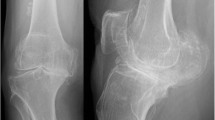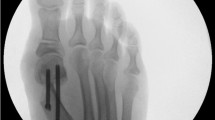Abstract
Purpose
The hypothesis was that an alteration of different surgical variables of ACL reconstruction would produce significant changes in post-operative static laxity of knee joint.
Methods
Joint laxity was acquired by a surgical navigation system for 17 patients just after graft fixation during single-bundle reconstruction with extra-articular lateral tenodesis. The analysed laxity parameters were: internal/external rotation at 30° (IE30) and 90° (IE90) of flexion, varus/valgus rotation at 0° (VV0) and 30° (VV30) of flexion and anterior/posterior displacement at 30° (AP30) and 90° (AP90) of flexion. As surgical variables, the angles between the tibial tunnel and the three planes were defined as well as the lengths of the tunnel and the relationship between native footprints and tunnels. The same analysis was performed for the femoral side. All surgical variables were combined in a multivariate analysis to assess for predictive factors between them and post-operative laxities values. To quantify the performance of each multivariate model, the correlation ratio (η 2) and the corresponding P value (*P < 0.050) have been evaluated.
Results
Multivariate analysis underlined statistically significant models for the estimation of: AP30 (η 2 = 0.987; P = 0.014), IE30 (η 2 = 0.995; P = 0.005), IE90 (η 2 = 0.568; P = 0.010), VV0 (η 2 = 0.932; P = 0.003). The parameters that greatly affected the identified models were the orientation of the tibial tunnel with respect to the three anatomical planes. The estimation of AP30, IE30 and IE90 got lower value as the orientation of the tibial tunnel with respect to transverse plane decreases. Considering the orientation to sagittal (\(\theta_{\text{SAG}}^{T}\)) and coronal (\(\theta_{\text{COR}}^{T}\)) plane, we found that their reduction provoked a decrease in the estimation of AP30, IE30 and IE90 (except \(\theta_{\text{SAG}}^{T}\) that did not appear in the estimation of AP30). The estimation of VV0 got an increase of \(\theta_{\text{SAG}}^{T}\), and \(\theta_{\text{COR}}^{T}\) which led to a laxity reduction.
Conclusion
The main finding of the present in vivo study was the possibility to determine significant effects on post-operative static laxity level of different surgical variables of ACL reconstruction. In particular, the present study defined the conditions that minimize the different aspects of post-operative laxity at time-zero after surgery.






Similar content being viewed by others
References
Abebe ES, Utturkar GM, Taylor DC, Spritzer CE, Kim JP, Moorman CT III, De Frate LE (2011) The effects of femoral graft placement on in vivo knee kinematics after anterior cruciate ligament reconstruction. J Biomech 44(5):924–929
Amis AA, Jakob RP (1998) Anterior cruciate ligament graft positioning, tensioning and twisting. Knee Surg Sports Traumatol Arthrosc Suppl 1:S2–S12
Bedi A, Maak T, Musahl V, Citak M, O’Loughlin PF, Choi D, Pearle AD (2011) Effect of tibial tunnel position on stability of the knee after anterior cruciate ligament reconstruction: is the tibial tunnel position most important? Am J Sports Med 39(2):366–373
Brophy RH, Voos JE, Shannon FJ, Granchi CC, Wickiewicz TL, Warren RF, Pearle AD (2008) Changes in the length of virtual anterior cruciate ligament fibers during stability testing: a comparison of conventional single-bundle reconstruction and native anterior cruciate ligament. Am J Sports Med 36(11):2196–2203
Brophy RH, Pearle AD (2009) Single-bundle anterior cruciate ligament reconstruction: a comparison of conventional, central, and horizontal single-bundle virtual graft positions. Am J Sports Med 37(7):1317–1323
Gabriel MT, Wong EK, Woo SL, Yagi M, Debski RE (2004) Distribution of in situ forces in the anterior cruciate ligament in response to rotatory loads. J Orthop Res 22(1):85–89
Goss BC, Hull ML, Howell SM (1997) Contact pressure and tension in anterior cruciate ligament grafts subjected to roof impingement during passive extension. J Orthop Res 15(2):263–268
Hantes ME, Zachos VC, Liantsis A, Venouziou A, Karantanas AH, Malizos KN (2009) Differences in graft orientation using the transtibial and anteromedial portal technique in ACL reconstruction: a magnetic resonance imaging study. Knee Surg Sports Traumatol Arthrosc 17(8):880–886
Howell SM, Barad SJ (1995) Knee extension and its relationship to the slope of the intercondylar roof. Am J Sports Med 23(3):288–294
Howell SM, Deutsch ML (1999) Comparison of endoscopic and two-incision techniques for reconstructing a torn anterior cruciate ligament using hamstring tendons. Arthroscopy 15(6):594–606
Howell SM, Gittins ME, Gottlieb JE, Traina SM, Zoellner TM (2001) The relationship between the angle of the tibial tunnel in the coronal plane and loss of flexion and anterior laxity after anterior cruciate ligament reconstruction. Am J Sports Med 29(5):567–574
Howell SM, Taylor MA (1996) Brace-free rehabilitation, with early return to activity, in knees reconstructed with a double-looped, semitendinosus and gracilis graft. J Bone Joint Surg Am 78(6):814–825
Howell SM (1998) Principles for placing the tibial tunnel and avoiding roof impingement during reconstruction of a torn anterior cruciate ligament. Knee Surg Sports Traumatol Arthrosc 6(Suppl 1):S49–S55
Hussein M, van Eck CF, Cretnik A, Dinevski D, Fu FH (2012) Prospective randomized clinical evaluation of conventional single-bundle, anatomic single-bundle, and anatomic double-bundle anterior cruciate ligament reconstruction: 281 cases with 3- to 5-year follow-up. Am J Sports Med 40(3):512–520
Järvelä T (2007) Double-bundle versus single-bundle anterior cruciate ligament reconstruction: a prospective, randomize clinical study. Knee Surg Sports Traumatol Arthrosc 15(5):500–507
Jepsen CF, Lundberg-Jensen AK, Faunoe P (2007) Does the position of the femoral tunnel affect the laxity or clinical outcome of the anterior cruciate ligament reconstructed knee? A clinical, prospective, randomized, double-blind study. Arthroscopy 23(12):1326–1333
Kondo E, Merican AM, Yasuda K, Amis AA (2010) Biomechanical comparisons of knee stability after anterior cruciate ligament reconstruction between 2 clinically available transtibial procedures: anatomic double bundle versus single bundle. Am J Sports Med 38(7):1349–1358
Lee MC, Seong SC, Lee S, Chang CB, Park YK, Jo H, Kim CH (2007) Vertical femoral tunnel placement results in rotational knee laxity after anterior cruciate ligament reconstruction. Arthroscopy 23(7):771–778
Loh JC, Fukuda Y, Tsuda E, Steadman RJ, Fu FH, Woo SL (2003) Knee stability and graft function following anterior cruciate ligament reconstruction: comparison between 11 o’clock and 10 o’clock femoral tunnel placement. Arthroscopy 19(3):297–304
Marcacci M, Zaffagnini S, Iacono F, Neri MP, Loreti I, Petitto A (1998) Arthroscopic intra- and extra-articular anterior cruciate ligament reconstruction with gracilis and semitendinosus tendons. Knee Surg Sports Traumatol Arthrosc 6(2):68–75
Markolf KL, Jackson SR, McAllister DR (2010) A comparison of 11 o’clock versus oblique femoral tunnels in the anterior cruciate ligament-reconstructed knee: knee kinematics during a simulated pivot test. Am J Sports Med 38(5):912–917
Markolf KL, Hame S, Monte Hunter D, Oakes DA, Zoric B, Gause P, Finerman GA (2002) Effects of femoral tunnel placement on knee laxity and forces in an anterior cruciate ligament graft. J Orthop Res 20(5):1016–1024
Martelli S, Lopomo N, Bignozzi S, Zaffagnini S, Visani A (2007) Validation of a new protocol for navigated intraoperative assessment of knee kinematics. Comput Biol Med 37(6):872–878
Middleton KK, Hamilton T, Irrgang JJ, Karlsson J, Harner CD, Fu FH (2014) Anatomic anterior cruciate ligament (ACL) reconstruction: a global perspective. Knee Surg Sports Traumatol Arthrosc 22(7):1467–1482
Muneta T, Koga H, Mochizuki T (2007) A prospective randomized study of 4-strand semitendinosus tendon anterior cruciate ligament reconstruction comparing single-bundle and double-bundle techniques. Arthroscopy 23(6):618–628
Musahl V, Plakseychuk A, VanScyoc A, Sasaki T, Debski RE, McMahon PJ, Fu FH (2005) Varying femoral tunnels between the anatomical footprint and isometric positions effect on kinematics of the anterior. Am J Sports Med 33(5):712–718
Outerbridge RE (1961) The etiology of chondromalacia patellae. J Bone Joint Surg Br 43-B:752–757
Rabuck SJ, Middleton KK, Maeda S, Fujimaki Y, Muller B, Araujo PH, Fu FH (2012) Individualized anatomic anterior cruciate ligament reconstruction. Arthrosc Tech 1(1):e23–e29
Shaerf DA, Pastides PS, Sarraf KM, Willis-Owen CA (2014) Anterior cruciate ligament reconstruction best practice: a review of graft choice. World J Orthop 5(1):23–29
Shelbourne KD, Klootwyk TE, Wilckens JH, De Carlo MS (1995) Ligament stability two to six years after anterior cruciate ligament reconstruction with autogenous patellar tendon graft and participation in accelerated rehabilitation program. Am J Sports Med 23(5):575–579
Signorelli C, Bonanzinga T, Lopomo N, Marcheggiani Muccioli GM, Bignozzi S, Filardo G, Zaffagnini S, Marcacci M (2013) Do pre-operative knee laxity values influence post-operative ones after anterior cruciate ligament reconstruction? Scand J Med Sci Sports 23(4):e219–e224
Signorelli C, Bonanzinga T, Grassi A, Lopomo N, Zaffagnini S, Marcacci M (2016) Predictive mathematical modeling of knee static laxity after ACL reconstruction: in vivo analysis. Comput Methods Biomech Biomed Engin 28:1–8
Simmons R, Howell SM, Hull ML (2003) Effect of the angle of the femoral and tibial tunnels in the coronal plane and incremental excision of the posterior cruciate ligament on tension of an anterior cruciate ligament graft: an in vitro study. J Bone Joint Surg Am 85-A(6):1018–1029
Tardy N, Mouton C, Boisrenoult P, Theisen D, Beaufils P, Seil R (2014) Rotational profile alterations after anatomic posterolateral corner reconstructions in multiligament injured knees. Knee Surg Sports Traumatol Arthrosc 22(9):2173–2180
Van der Bracht H, Verhelst L, Stuyts B, Page B, Bellemans J, Verdonk P (2014) Anatomic single-bundle ACL surgery: consequences of tibial tunnel diameter and drill-guide angle on tibial footprint coverage. Knee Surg Sports Traumatol Arthrosc 22(5):1030–1039
Yasuda K, Kondo E, Ichiyama H, Tanabe Y, Tohyama H (2006) Clinical evaluation of anatomic double-bundle anterior cruciate ligament reconstruction procedure using hamstring tendon grafts: comparisons among 3 different procedures. Arthroscopy 22(3):240–251
Zaffagnini S, Bruni D, Martelli S, Imakiire N, Marcacci M, Russo A (2008) Double-bundle ACL reconstruction: influence of femoral tunnel orientation in knee laxity analysed with a navigation system—an in vitro biomechanical study. BMC Musculoskelet Disord 25:9–25
Zaffagnini S, Signorelli C, Lopomo N, Bonanzinga T, Marcheggiani Muccioli GM, Bignozzi S, Visani A, Marcacci M (2012) Anatomic double-bundle and over-the-top single-bundle with additional extra-articular tenodesis: an in vivo quantitative assessment of knee laxity in two different ACL reconstructions. Knee Surg Sports Traumatol Arthrosc 20(1):153–159
Zaffagnini S, Martelli S, Acquaroli F (2004) Computer investigation of ACL orientation during passive range of motion. Comput Biol Med 34(2):153–163
Author information
Authors and Affiliations
Corresponding author
Ethics declarations
Conflict of interest
The authors declare that they have no conflict of interest.
Funding
This work was supported by Italian Ministry of Health, Progetto RF Ministero Salute [grant number 2010-2312173].
Ethical approval
Provided by the Institutional Review Board.
Informed consent
Informed consent was obtained from all the participants included in the study.
Rights and permissions
About this article
Cite this article
Zaffagnini, S., Signorelli, C., Bonanzinga, T. et al. Technical variables of ACL surgical reconstruction: effect on post-operative static laxity and clinical implication. Knee Surg Sports Traumatol Arthrosc 24, 3496–3506 (2016). https://doi.org/10.1007/s00167-016-4320-x
Received:
Accepted:
Published:
Issue Date:
DOI: https://doi.org/10.1007/s00167-016-4320-x




